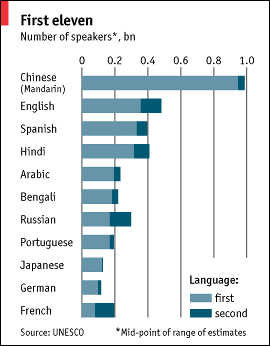|
Endangered languages
Babel runs backwards Dec 29th 2004 From The Economist print edition | ||
 The
world's languages are disappearing at the rate of one a fortnight. What to do?
AND they said one to another, go to, let us build us a city and a tower, whose
top may reach unto heaven; and let us make a name, lest we be scattered abroad
upon the face of the whole Earth...And the Lord said, behold, the people is one,
and they have all one language; and this they begin to do...let us go down, and
there confound their language, that they may not understand one another's
speech. So the Lord scattered them abroad from thence upon the face of all the
Earth.” That ended the building of the tower of Babel, and started the confusion
of tongues. The
world's languages are disappearing at the rate of one a fortnight. What to do?
AND they said one to another, go to, let us build us a city and a tower, whose
top may reach unto heaven; and let us make a name, lest we be scattered abroad
upon the face of the whole Earth...And the Lord said, behold, the people is one,
and they have all one language; and this they begin to do...let us go down, and
there confound their language, that they may not understand one another's
speech. So the Lord scattered them abroad from thence upon the face of all the
Earth.” That ended the building of the tower of Babel, and started the confusion
of tongues. | ||
| Bridgeman | ||
|
The usual way to read this passage from Genesis is
that God punished his people for getting too uppity. Multilingualism was a curse
to bring them down to Earth—an expulsion from the paradise of effortless
communication. If that is what happened, the Lord certainly made a thorough job
of it. The single language that may have been spoken at the dawn of modern
mankind, perhaps 60,000 years ago, gradually diversified into huge numbers.
Perhaps tens, possibly hundreds of thousands of languages may have evolved and
then died as the people who spoke them first flourished, then perished. The vast
majority left no written trace, and so no trace at all. A few, such as Sumerian,
Etruscan and Mayan, survived in writing but became extinct in daily life.
Others, such as Latin, Sanskrit and ancient Greek, were preserved in written
form but also evolved into live new tongues. Languages have been coming and going for millennia, but in recent times there has been less coming and a lot more going. When the world was still populated by hunter-gatherers, small, tightly knit groups developed their own patterns of speech independent of each other. Some linguists reckon that 10,000 years ago, when the world had just 5m-10m people, they spoke perhaps 12,000 languages between them. Soon afterwards many of those people started settling down to become farmers, and their languages too became more settled and fewer in number. In recent centuries, colonisation, trade, industrialisation, the development of the nation-state and the spread of universal compulsory education, among other things, have helped to extirpate many languages that had previously prospered in isolation. And in the past few decades, thanks to globalisation and better communications, the rate of attrition has greatly accelerated, and dominant languages such as English, Spanish and Chinese are increasingly taking over. At present the world has about 6,800 distinct languages (and many more dialects), according to Ethnologue, a database maintained by the Summer Institute of Linguistics in Dallas. The distribution of these languages is hugely uneven. The general rule is that temperate zones have relatively few languages, often spoken by many people, whereas hot, wet zones have lots, often spoken by small numbers. Europe has only around 200 languages; the Americas about 1,000; Africa 2,400; and Asia and the Pacific perhaps 3,200, of which Papua New Guinea alone accounts for well over 800. The median number of speakers is a mere 6,000, which means that half the world's languages are spoken by fewer people than that. Already well over 400 of the total of 6,800 languages are close to extinction, with only a few elderly speakers left. The list makes melancholy reading. Pick, at random, Busuu in Cameroon (eight remaining speakers), Chiapaneco in Mexico (150), Lipan Apache in the United States (two or three) or Wadjigu in Australia (one, with a question-mark): none of these seems to have much chance of survival. Worse, probably 3,000 or so others are also endangered. Linguists classify languages on a scale ranging from “safe” (learnt by all children in the group, and spoken by all its members) to “critically endangered” (only a few old speakers). On that scale, “endangered” comes in the middle, meaning that children no longer learn the language and only adults speak it. Dying as—and because—we speak All the experts agree that by the end of this century the number of languages in use will be much smaller than it is now, but they disagree on how much smaller. The optimists think that, with care and effort, the decline can be managed so that about half will survive. The pessimists reckon that in 100 years' time 90% of the world's languages will be gone, and that a couple of centuries from now the world may be left with only 200 tongues. | ||
| Bridgeman | ||
 When
the British were linguists When
the British were linguistsIt is tempting to think that life could be simpler, better and perhaps more peaceful if everybody could settle on one, or just a few, languages, leaving less room for misunderstanding. But there is little evidence that monolingualism promotes peace. In Northern Ireland, Protestants and Catholics speak the same language. Vietnam and Somalia are both predominantly monolingual. When Yugoslavia fell into civil war, most of its people were speaking Serbo-Croat. A shared language may even make people more bellicose. According to a legend of the Acoma tribe in New Mexico, the goddess Iatiku caused languages to multiply so that people would quarrel less. Certainly, attempts to enforce a single language tend to provoke strong reactions. James Crawford, an American writer on the subject, points to the conclusion of an 1868 federal commission on making peace with the Plains Indians: “In the difference of language today lie two-thirds of our troubles... | ||
| Bridgeman | ||
|
Schools should be established which children should
be required to attend; their barbarous dialects should be blotted out and the
English language substituted.” The extermination happened in the end—most Native
American languages are now dead or dying—but not without a struggle. For the
Kurds in Turkey, and for some other minorities, efforts to suppress their
language have not succeeded yet. But minority languages disappear for many reasons. It could be because their speakers are beset by some calamity: droughts, floods, earthquakes, or imported epidemics such as swept through the indigenous populations of Latin America when the Europeans arrived. Today HIV/AIDS in some African countries is wiping out entire generations, and sometimes their language with them. However, most languages disappear because their speakers voluntarily abandon them, says Matthias Brenzinger, of Dartmouth College, New Hampshire. Where a dominant language is associated with progress and economic success, speakers of minority languages come under pressure to learn it in order to get on. The most obvious example in the modern world is English, which is advancing by leaps and bounds—encouraged by the internet. According to Global Reach, a communications consultancy, English accounts for two-thirds of all web content. | ||
 A small number of dominant languages already rule the globe. Of the
world's
6 billion-odd people, nearly a sixth speak Mandarin Chinese as a first
language. If you add the rest of the top 11—English, Hindi, Spanish,
Arabic
and so on—plus people who speak one of these as a second language,
your
list already covers well over half of mankind (see table). A small number of dominant languages already rule the globe. Of the
world's
6 billion-odd people, nearly a sixth speak Mandarin Chinese as a first
language. If you add the rest of the top 11—English, Hindi, Spanish,
Arabic
and so on—plus people who speak one of these as a second language,
your
list already covers well over half of mankind (see table).As the big languages advance, the minority ones retreat. They come to be seen as backward and embarrassing. As children stop learning them and fewer people speak them, they become ever less useful. In the end, the last speakers die, taking their languages to the grave with them. Good riddance, say some. Throughout human history, languages have been born, evolved and died; why not let nature take its course? If speakers of minority languages really wanted to hang on to them, they would make strenuous efforts to keep them alive. If they do not, it means they no longer have a use for them. Trying to save moribund languages is pointless Misguided cultural Darwinism, cry the linguists. Endangered languages were perfectly suited to their speakers' way of life until their habitat changed through the intervention of other humans. There is a close parallel with man's encroachment on the natural environment, but the environmentalists have made faster progress..
Greenery has become mainstream, and
preserving
some rare butterfly, wildflower or ecosystem is considered a worthy
goal.
In the same way, languages should be preserved to safeguard diversity,
say
these linguists: a widespread loss of languages is the equivalent of an
ecological disaster. | ||
| Bridgeman | ||
 Learning
French a century ago—one more tongue for multilingual Africans Learning
French a century ago—one more tongue for multilingual AfricansOddly, the world has woken up to this only fairly recently, though over the past 15 years or so a rash of books, articles and initiatives has been raising the alarm. The top priority, says David Crystal in his book, “Language Death”, is information-gathering. With so many languages at risk, the effort has to be concentrated on the most pressing cases. | ||
| Bridgeman | ||
|
Perhaps
two-thirds of the world's languages have never been written down, so
there
is an urgent need to record what may be about to vanish. Audio and
video
recordings can help, but the main need is for basic grammars and
dictionaries, which are expensive to produce. Mr Crystal calculates
that,
assuming an average cost of $192,000 per language over three years, the
cost of recording 3,000 endangered languages might run to $575m. But
that
is one guess among many. Another big constraint is the shortage of researchers undertaking such work, says Peter Austin, of London University's School of Oriental and African Studies. His programme is helping to train more. It forms part of an endangered-languages project financed, to the tune of £20m ($39m) over ten years, by the Lisbet Rausing Charitable Fund. The Volkswagen Foundation is also paying for some documentation work, and other organisations, including UNESCO, are helping. The sums involved are mostly modest, but the fact that money is being spent at all helps to raise awareness, says Akira Yamamoto, of the University of Kansas. He argues that the best and cheapest way of documenting endangered languages is to work with the communities concerned and train their own people in research techniques. Clearly, there is no point in trying to save a language unless the speakers wish it, but most seem to be increasingly interested. In recent decades several moribund languages, including Hawaiian, Maori and Welsh, have been successfully revived. Nicholas Ostler, of the British-based Foundation for Endangered Languages, draws a parallel with fine art: though people do not need their ancient mother tongue for physical survival, it makes life far richer. Hebrew provides an unusual example. It was brought back from the embalmed state of being used only for religious purposes to become the official, and universally used, language of the state of Israel. But that required extraordinary circumstances and efforts—and more or less killed off another Jewish lingua franca, Yiddish. Sharper minds, better understanding Everybody agrees that endangered languages can be saved only if their speakers are prepared to become bi- or multilingual. That way, they can use the dominant language for work and official purposes, and their own language among family and friends. Monolingual Anglo-Saxons shudder at the thought, but linguists point out that, for most of humanity most of the time, bi- or multilingualism has been the natural state of affairs. Children can easily pick up several languages if they are exposed to them early. Indeed, there is evidence that people who speak more than one language are mentally more flexible and more creative than monoglots. Swedish children learn English in primary school, which seems to do no harm to their Swedish (or to the rest of their education). In his book “Spoken Here”, Mark Abley, tongue slightly in cheek, argues that the story of Babel may have been misunderstood. The Lord urged Noah and his people “to be fruitful, multiply and replenish the Earth”. They duly multiplied, but stayed put and became overcrowded. Mixing up their language was a way of getting them to spread out. It was a blessing in disguise. The demise of any language is a loss for all mankind, but most of all a loss for its speakers. As one Navajo elder, quoted by Mr Yamamoto, told his grandson: “If you don't breathe, There is no air. If you don't walk, There is no earth. If you don't speak, There is no world.” | ||